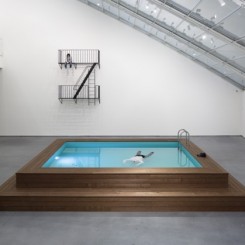Elmgreen & Dragset, “Biography” and “The Old World.”
Astrup Fearnley Museet (Strandpromenaden 2, 0252 Oslo) March 21–August 24, 2014
Galerie Perrotin (50 Connaught Road, Central, Hong Kong) April 3–May 3, 2014
The art of Michael Elmgreen (b. 1961, Copenhagen, Denmark) and Ingar Dragset (b.1969, Trondheim, Norway) treats the event and experience of exhibitions as their media—including theatrical interaction with the audience. While frequently playful, most of their work has a strong political seam including social-economic critiques, particularly regarding gay rights. They have presented shows mainly in Europe, including at the Serpentine Gallery and Tate Modern in London; the Museum Boijmans Van Beuningen in Rotterdam; ZKM, Karlsruhe; and Kunsthalle Zurich. In 2009 they represented Denmark and Norway at the Venice Biennale, and in 2012 participated in the Liverpool Biennial. In Autumn 2013, for their exhibition “Tomorrow” at The Victoria & Albert Museum in London, Elmgreen & Dragset “redeveloped” parts of the museum as the apartment of a fictional architect. An exhibition called “Biography” has just opened at the Astrup Fearnley Museum, and simultaneously at Galerie Perrotin in Hong Kong—for the first time in Asia—which revisits themes encountered in their V&A show and also their cast bronze rocking boy sculpture from the empty Fourth Plinth in London’s Trafalgar Square 2012, “Powerless Structures, Fig. 101”.
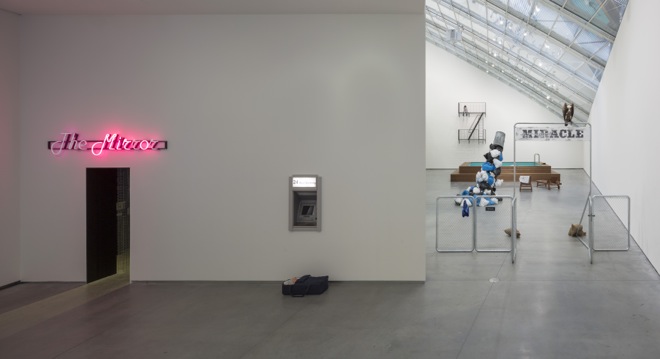
Elmgreen & Dragset, “Biography”, installation views. At Astrup Fearnley Museet, 2014. Courtesy of the artist; photo by Anders Sune Berg
艾墨格林与德拉格塞特,《传记》,展览场景,奥斯陆Astrup Fearnley现代美术馆,2014。图片:Anders Sune Berg
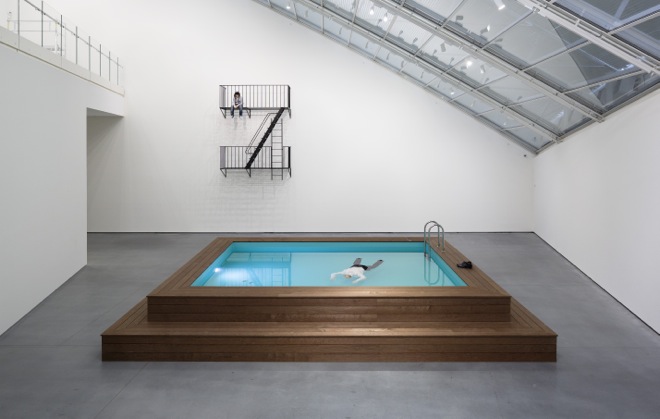
Elmgreen & Dragset, “Biography”, installation views. At Astrup Fearnley Museet, 2014. Courtesy of the artist; photo by Anders Sune Berg
艾墨格林与德拉格塞特,《传记》,展览场景,奥斯陆Astrup Fearnley现代美术馆,2014。图片:Anders Sune Berg
Chris Moore: Shall we begin with Hong Kong?
Ingar Dragset: The Hong Kong show is inspired by our experiences with the Victoria & Albert Museum show “Tomorrow” [in 2013]. In that exhibition, we were dealing with a disappearing Europe, exemplified by Britain with its shrinking Empire, and also European history, which doesn’t seem to have the same impact or legacy anymore; it’s not perceived in the same way—our traditions and architectural spaces, but also political ideas. The social structures that have been very prevalent or which we have taken for granted are not there as constants any more. For instance, the welfare state can be eroded by forces related to the international globalized economy and communication and financial systems. It is fun to extend this to a (smaller) show in Asia— in Hong Kong, a new financial center which is definitely not “old Europe”. We had never been to China or Hong Kong, so we based this show on the fictionalized image of China—of the “new world”.
CM: That’s actually very Chinese—traditional Chinese art is based on fictions—fictional landscapes and settings, but also mythologies and stories.
ID: This is something that interests us, obviously. We wanted also to continue this way of doing shows based on domestic settings, though we’re not changing the gallery completely here— we’re just using domestic elements to set a certain atmosphere, such as [adding] carpeted floors. Michael has been living in England for five years now, so we have to have carpeted floors!
CM: But the gallery is in a very corporate building. The feeling of dislocation will be even stronger than in a museum.
ID: Yes, we like that contrast. And they have a panoramic window, so we will utilize this skyline [view] of Hong Kong as en element in the exhibition. The title of the show is “The Old World”, so it is again us dealing with the fiction of Hong Kong, but also looking back upon Old Europe from this imagined place.
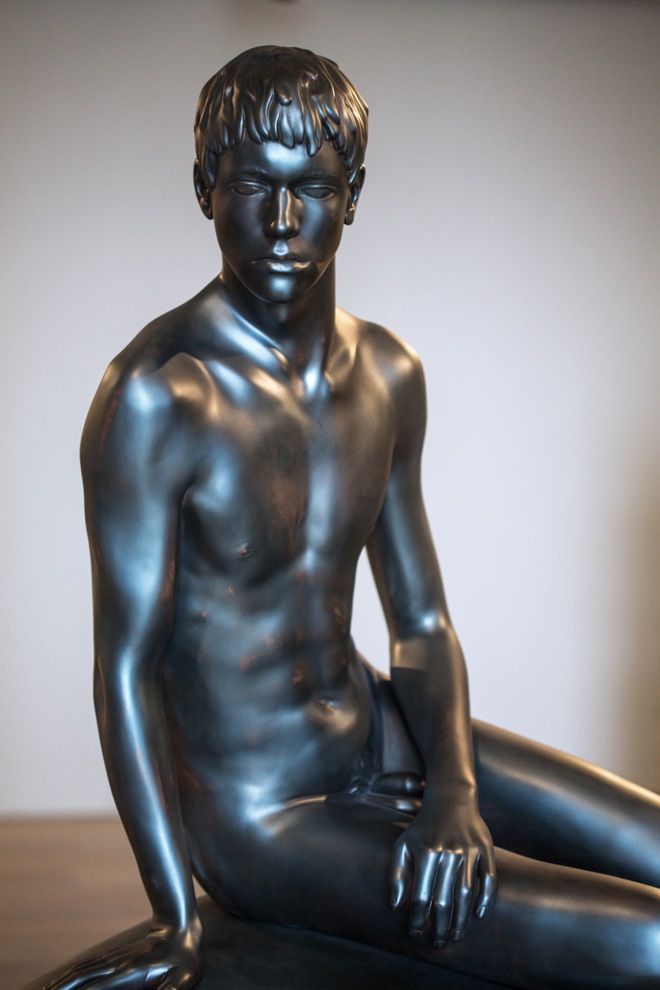
Elmgreen & Dragset. “The Old World”, installation views. At Galerie Perrotin, Hong Kong, 2014. Photo by Joyce Jung
艾墨格林与德拉格塞特,《旧世界》,展览场景,贝浩登画廊(香港),2014。图片:Joyce Jung
The Hong Kong show includes two key displays. Firstly, a hermaphrodite version of Copenhagen’s famous “Little Mermaid” sculpture honoring Hans Christian Andersen’s fairytale of metamorphosis and the separate worlds of sea and people, which sits on a rock on the edge of the harbor and was exhibited in the Danish Pavilion in Shanghai during the World Exposition in 2010 (whose exhibition Ai Weiwei famously broadcast back to the site in Copenhagen where the sculpture usually resides). Elmgreen & Dragset’s version is more clearly a teenage boy—most probably the older version of the boy on the rocking horse displayed in Trafalgar Square). Secondly, a black-room lounge reminiscent of their V&A installation has been designed, which converts the “office” space of the corporate building in which Gallery Perrotin is situated into a dislocating 2001 science-fiction, pulling anachronistic furniture into an abstract “virtual space”.
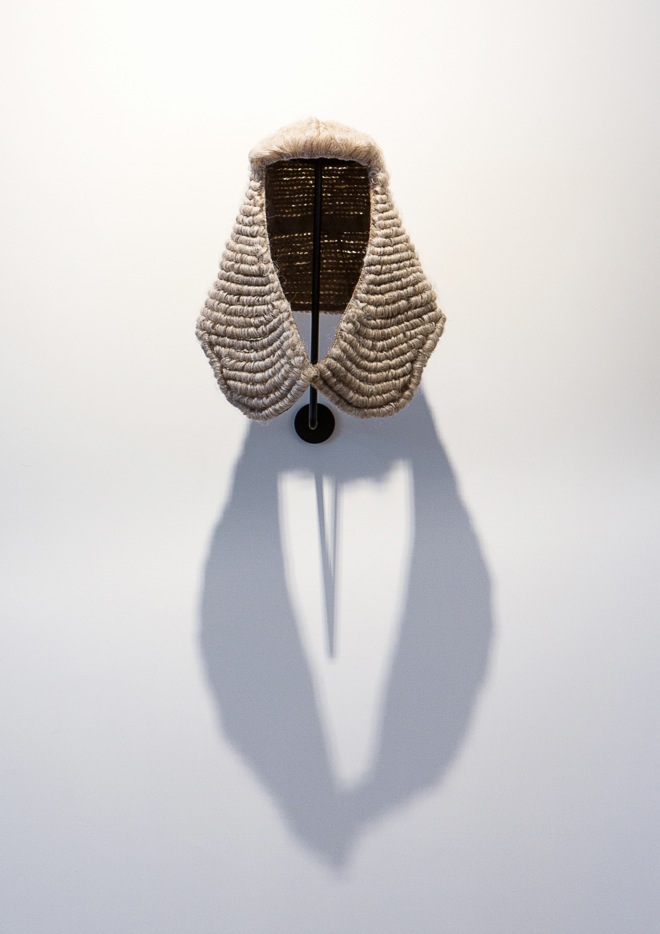
Elmgreen & Dragset. “The Old World”, installation views. At Galerie Perrotin, Hong Kong, 2014. Photo by Joyce Jung.
艾墨格林与德拉格塞特,《旧世界》,展览场景,贝浩登画廊(香港),2014。图片:Joyce Jung
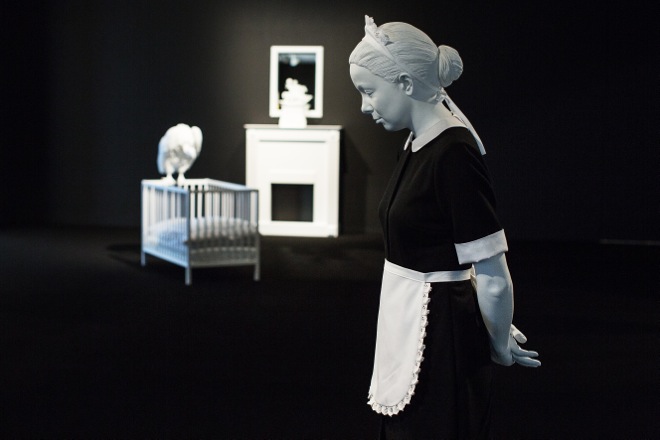
Elmgreen & Dragset. “The Old World”, installation views. At Galerie Perrotin, Hong Kong, 2014. Photo by Joyce Jung.
艾墨格林与德拉格塞特,《旧世界》,展览场景,贝浩登画廊(香港),2014。图片:Joyce Jung
CM: It also relates to you as artists.
ID: The fiction of “Elmgreen & Dragset”? —of course! It has very much to do with the show we are doing now, which is called “Biography” [at Astrup Fearnly Museum, Oslo]. That exhibition is an attempt to make a kind of survey show giving people a good idea of what we have been doing during the last 20 years, but at the same time we are very honest about this not being the full story. There’s no chronology in it, there’s no real “Elmgreen & Dragset”, and it’s not autobiographical in any way, although a number of works are based on an imagined third person who appears between Michael and me—this impossible, non-existent identity between two people. I guess you cannot even write the autobiography of two people.
CM: Well, what’s an authentic autobiography anyway?
ID: Exactly!
CM: A number of artists are dealing with these concepts of identity and fictional persona. In China, the most obvious is Xu Zhen with MadeIn Company, and then the company curating himself. With regard to the Victoria & Albert Museum, was there something in particular that you were trying to draw attention to or to subvert? Of course, the V&A refers to what was the royal collection, and is full of all sorts of strange things, including the history of underwear, for instance.
ID: We haven’t included any underwear, really, but we did include the fig leaf used for the “David” sculpture every time Queen Victoria would come to the museum. It was in the bedroom as you entered on the left side.
When you isolate that work—they were extremely protective of the modesty and chastity of the Queen—suddenly and inadvertently you sexualize it, because of course, it’s got an enormous bulge!
CM: Exactly, it draws attention to it—you wonder “what’s under there?”
ID: That maybe gives one clue to a sort of subversion, which is: us sexualizing some of these objects at the museum which they [the V&A] rarely do. I mean, sexual connotation is mostly underplayed—shifted off the work.
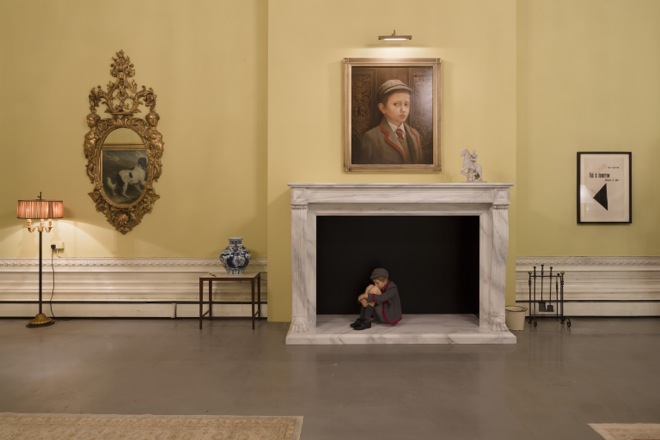
Elmgreen & Dragset. “Tomorrow”, installation views. The Victoria & Albert Museum, London, 2013. Courtesy of the artist; photo by Anders Sune Berg.
艾墨格林与德拉格塞特,《明天》,展览场景,伦敦维多利亚与阿尔伯特博物馆,2013。图片:Anders Sune Berg
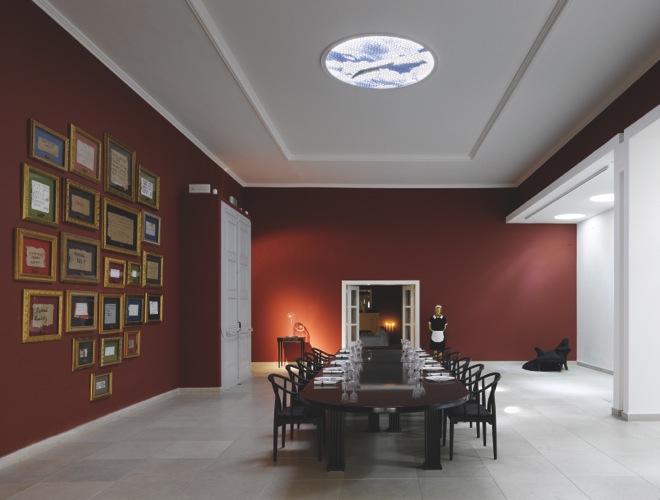
Elmgreen & Dragset. “The Collectors” (Danish Pavilion), 53rd Venice Biennial, 2009. Photo by Anders Sune Berg
艾墨格林与德拉格塞特,《收藏家》,威尼斯双年展丹麦馆,2009。图片:Anders Sune Berg
CM: In the scenography of the exhibition at the V&A, the absence of the parents is strongly felt [the boy, in school uniform, sits cradling his knees in the clean fireplace/proscenium stage, echoing a naked boy decorating a fig leaf-shaped ashtray nearby, upon which rests his Father’s abandoned cigar]. There is a maid and a butler, but no parents—even their portraits are missing from the walls, their empty chairs separated by a table upon which sits an ormolu clock, and boxes are filled waiting for the removal men.
ID: And we also showed that grand dining table with the crack in the middle of it called “Table for Bergman”. Bergman has always been a big inspiration for us, and he was often preoccupied with the breakdown of families, in spite of everyone’s “best intentions”. We initially showed the table in the setting we created for “The Collectors” in the Danish pavilion at the 2009 Venice Biennale, but at the V&A it tells the story of a different family. It becomes about the breakdown of the Swann family. In our fictive universe, there was an old man, Norman Swann, the architect [a false avatar of noted Victorian architect, Richard Norman Swan (2.), who has lived in this apartment in South Kensington (in the V&A)], and was the last living person in the family.
CM: It also refers to Proust.
ID: Of course. A booklet also accompanied the show. We liked the idea that you could go home and read it and remember the show, or maybe even go back and have a second look and follow the script, which also refers to different rooms.
CM: The booklet encourages us to consider where the show exists after the show itself ceases to exist —in the accumulation of physical and mental evidence, which changes?
ID: Yes, it changes all the time. This goes back to biography, identity and how we remember.
CM: Which again relates back to Proust. How are some of these themes being picked up in Hong Kong?
ID: They are a bit, but here we will do a small film, whereas at the V&A we wrote the script for an unfinished or unrealized film. In Hong Kong, we will use the objects in the show as protagonists, in that we will let the work observe visitors to the gallery. We will have actors playing visitors, but the camera is basically in the position of the sculptures; in large part, the space and the exhibition is telling the story.
CM: That is the conceit, but the reality is that looking back afterwards, the objects really will have been animated, sort of magically, because they really will have been looking at these characters, because the fact that the characters are just actors is irrelevant—the actors are also characters. So what is fake becomes real, or as real as anything else.
ID: It’s much more surreal, this setting in China, than something like the Venice Biennial or the V&A. We don’t want to attempt any sort of realism here. Also, we don’t know the context.
CM: Why not get a Feng Shui expert to give his expert advice on how the exhibition should be installed?
ID: That would be interesting.
CM: There are 20-30 artists around the world from different cultures who use humor as a primary medium. Examples are Sun Yuan & Peng Yu, Erwin Wurm and Maurizio Cattelan, and one of the things that define this group is that very often, from exhibition to exhibition, piece to piece, the work is radically different; it is very difficult to identify a specific oeuvre. Another thing that links them is the way humor is used in strategic and subversive ways that have never been used before—at least in art. Why is this happening now? Is it a symptom of the age or globalization?
ID: There are some questions as to what is humorous. For instance, the boy on the rocking horse in Trafalgar Square [“Powerless Structures, Fig. 101” (2011), which also appears in toy form in the V&A]—is it funny or melancholic or critical? Where is the emphasis? It is cheeky, we are taking the piss —a little bit. The grandness of the square and its history are very important—these heroic moments it memorializes. We don’t have the same passion for the past any more.
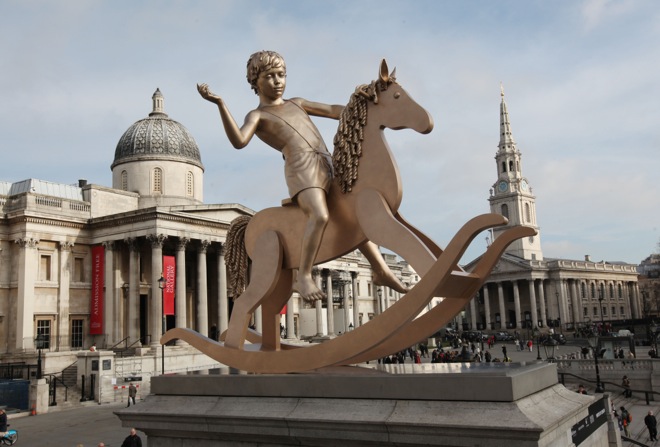
Elmgreen & Dragset, “Powerless Structures”, bronze cast, 4.11 m high, 2012. At the Fourth Plinth, Trafalgar Square, London. Commissioned by the Mayor of London. Courtesy of the artist; photo by James O. Jenkins
艾墨格林与德拉格塞特,《无力的结构101号》,青铜雕塑,4.11 m, 2012。伦敦特拉法加广场的“第四柱基”项目。图片:James O. Jenkins
CM: Well, the ambiguity is necessary— otherwise the joke would not be as poignant. There has to be an element of romance in this as well.
ID: I like the idea—exactly, the romance is there. We took the existing visual language of the square very seriously—its history. For instance, it was sculpted here in Berlin as a 1:3 size model, and we worked with traditional techniques and materials to create this “new kid on the block”. It was then transported to London, where it was painstakingly measured bit by bit and scaled up to the 1.1 model, which was 4,10 meters tall. This one was cut up in parts that went to a traditional metal foundry and got cast and welded together and then got brushed and polished for weeks. A lot happened along the way. What looked really cute in the model looked monstrous in full scale! We had to redo a lot of details.
CM: This problem of scale is interesting—for instance, the hands of Michelangelo’s “David” are disproportionately large relative to the rest of his body. But you concentrate on different things but when you scale-up—strange things happen.
ID: Exactly. Of course, we had to make the head big because it’s so far away [from the viewer]. Otherwise, it would look like a pea-head!
CM: Well, it makes everyone else look like a child too. There is a difference between “child-like”, which is charming, and “childish”, which is infantile—but this does both. It works for the object itself, but also co-opts everyone else first by charming them—for instance the national hero, Lord Nelson, becomes a toy-soldier— then through subversion, and finally by making us somehow childish. How important is joking with the audience for your art?
ID: We are definitely co-opting the audience. I came from the theater side of art, and Michael was also interested in performance and theater and worked in theater groups in Copenhagen before we met. I think maybe this has influenced the way we make art. We are always thinking of the audience experience in relation to the art. We try to think about who the audience is, yet without making things for a specific audience. We try to keep things open, so it’s possible for different readings of the work.
CM: Also to change the audience?
ID: I don’t know if you can really change people directly with art. Maybe over time, when there have been sufficient influences from a number of artists and in combination with other things, like today in combination with technology, which is maybe a more avant-garde area than art is. I think that art today can be a meeting-point. An art experience today is one of the few 3-D, real-time experiences people can have, and it is becoming increasingly popular to go to art exhibitions at both museums and galleries. Never has there been a bigger art audience than there is today.
Art can be a meeting place for many different ideas and also a place where you can keep some ideas alive, because they don’t necessarily disappear immediately into discussions about being purposeful, functional or useful.
Of course, we do use humor as a tool for communication. People are more willing to accept a work when they can laugh about themselves at the same time as they are confronting something more serious—otherwise, the subject matter can be quite heavy.
CM: But you’re using more seductive methods or strategies than, say, someone like Paul McCarthy, who wants to hit you over the head first.
ID: I like to be hit over the head—I enjoy it!
CM: They’re both great experiences! But they are different approaches—charm or assault.
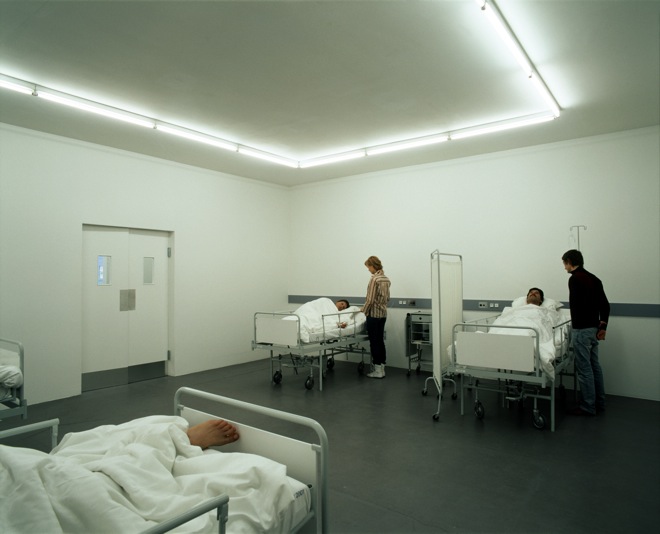
Elmgreen & Dragset, “Please keep quiet”, installation (hospital beds, wax figures, pajamas, bedding, swinging doors, tables, sink, mirror, ward screen, books; hospital room with four beds occupied by three male figures), 2003. Courtesy of the artist; photo by Anders Sune Berg
艾墨格林与德拉格塞特,《请保持肃静》,装置,2003。图片:Anders Sune Berg
ID: I don’t think we really scare anyone. People may feel uncomfortable inside certain installations that we have done, for instance this hospital room. If you go through the National Gallery in Copenhagen, and you go from a “Golden Age” painting, like by Vilhelm Hammershøi (1864-1916), and suddenly you are in a room with four hospital beds with mannequin patients lying there, there is…
CM: …a sense of displacement?
ID: Yes, displacement. You hear stories from the guards at the museum. Some people have to run out, some say it really smells like a hospital—and it does not, there is no smell! It’s all in people’s minds. The element of surprise is important in our work, like in Prada Marfa (2005). You drive along Highway 90 for 3 hours, and suddenly you see lights by the side of the road, and you might be hoping for a gas station or a diner, and then it’s a sodding boutique selling stiletto shoes in the middle of the desert.
CM: Is it still there? Recently there was a threat to remove it because it was classified as advertising.
ID: It is.
CM: Because it is also advertising—it is both.
ID: I don’t think Prada has been sad about it! But it was not a Prada project— they were never involved. It was not a commission. It has had completely its own life in the 10 years since we did it.
CM: It has to be cleaned every so often?
ID: There is a rancher in Valentine, the ghost-town, that’s fairly close to the shop who comes by every now and then and vacuums up the dead bugs, because you can’t see the floor anymore!
CM: So the local government has given up trying to classify it as advertising?
ID: Well, all that came about because Playboy magazine commissioned another artwork that included their logo, further down the street. That was obviously advertisement. Prada Marfa has got the permission to stay.
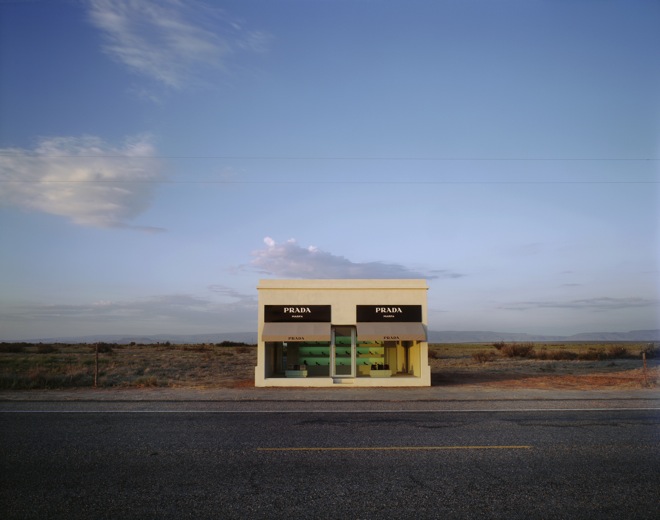
Elmgreen & Dragset, “Prada Marfa”, sealed mockup of a Prada boutique, 760 x 470 x 480 cm, 2005. At Marfa, Texas. Courtesy of the artist; photo by Lizette Kabré / James Evans
艾墨格林与德拉格塞特,《普拉达·玛尔法》,2005。图片:Lizette Kabré / James Evans
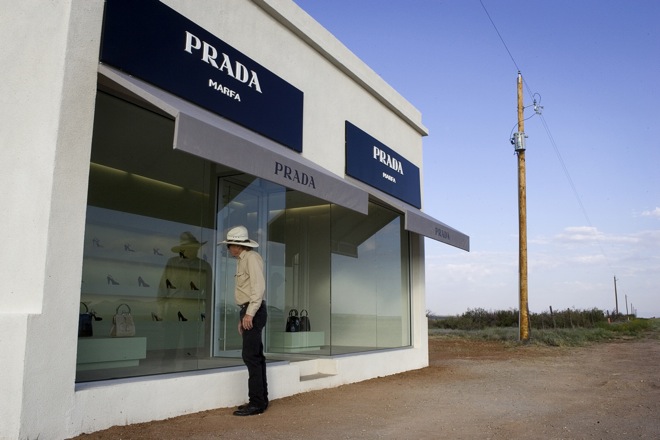
Elmgreen & Dragset, “Prada Marfa”, sealed mockup of a Prada boutique, 760 x 470 x 480 cm, 2005. At Marfa, Texas. Courtesy of the artist; photo by Lizette Kabré / James Evans
艾墨格林与德拉格塞特,《普拉达·玛尔法》,2005。图片:Lizette Kabré / James Evans
Major exhibitions
2003
Won public competition to design a memorial in Berlin to the gay victims of the Nazi regime. A grey “stele” concrete box, almost identical to those in the field of stele that comprise “The Memorial to the Murdered Jews of Europe” (2005) designed by Peter Eisenman, is situated on the opposite side of the street in the Tiergarten. A small window in the side gives visitors a view a video of two men kissing.
2005
“Prada Marfa” installation on the Route 90 highway near Valentine, Texas, U.S.A., in which a fake Prada shop displays actual Prada wares, shoes and handbags, picked out and provided by Miuccia Prada herself from the fall/winter 2005 collection; Prada allowed Elmgreen and Dragset to use the Prada trademark for this work.
2009
53rd Venice Biennale, Danish and Nordic Pavilion “The Collectors”



